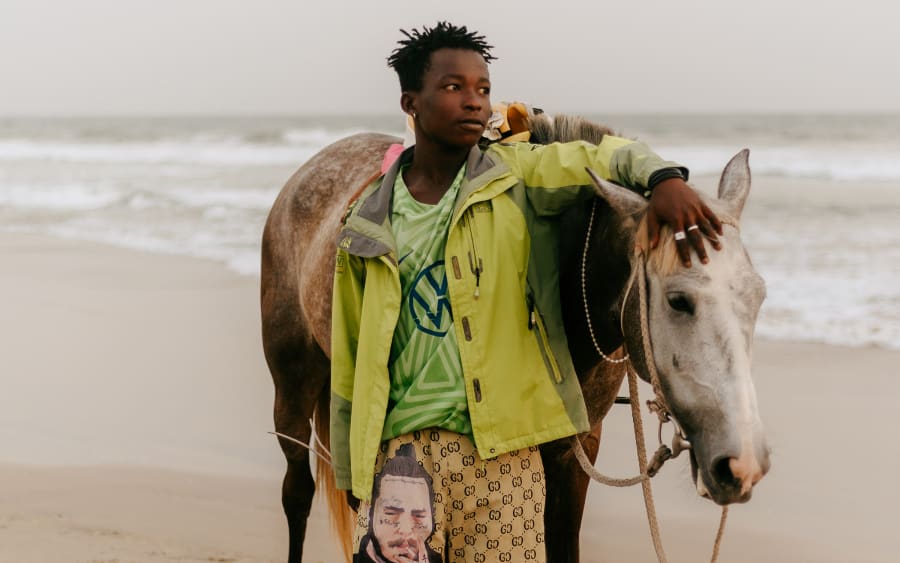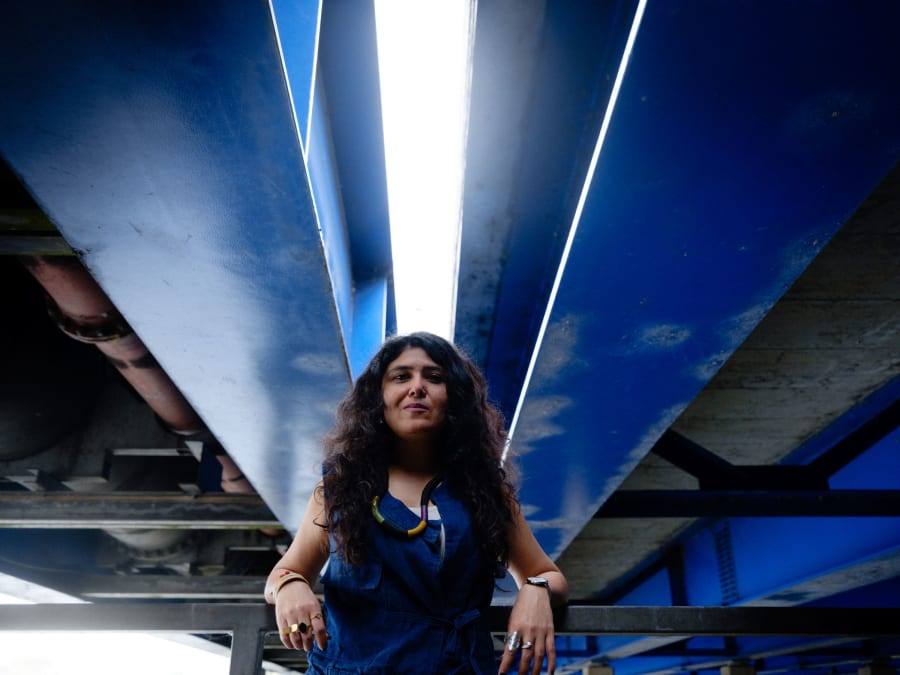While cities extend in space, they also exist in time. And traces of the past are everywhere in Lahore. It’s not unusual for a plaza built in 2023 to have a wall adjacent to the boundary of an 18th-century building. On any main road you’re likely to see the latest car models next to a bullock cart identical to ones used 5,000 years ago in the Indus Valley. This diversity is echoed by the Lahoris’ numerous ethnic backgrounds, religious beliefs, and languages. You may hear Punjabi, Saraiki, Pashto, Urdu, and English spoken in a market, along with a variety of dialects – each associated with a specific history.
This multiplicity is also reflected in the art presented in the city. While a large-scale replica of a paper horse (something associated with indigenous nomadic tribes) may occupy a prime spot in a public square, a bronze statue of Lionel Wendt, an educator from the colonial period, stands outside a major university. On street vendors’ poster stands images of famous European artworks hang next to photos of Indian film stars.
In terms of modern and contemporary art, Lahore’s largest contribution occurs in art education. Many Pakistani artists are the alumni of the city’s National College of Arts (NCA), Beaconhouse National University (BNU), and College of Art & Design, University of the Punjab. These institutions have also produced great academics, writers, curators, and art administrators. Qudsia Rahim, a graduate of NCA, is now the executive director of the Lahore Biennale Foundation, whose upcoming edition is being curated by John Tain, former head of research at Hong Kong’s Asia Art Archive.
The title of Lahore’s third biennial, ‘Of Mountains and Seas’ (originally scheduled for February and now slated to open on October 5), revolves around the themes of ecology and sustainable futures. Tain has invited both local and international artists to present their work, noting that, ‘Lahore is not alone in confronting challenges caused by climate change.’ Yet in Pakistan these topics have a particular resonance. In 2022, the country was hit by the worst floods of its history, a disaster that claimed numerous lives, livestock, houses, and possessions.
Art has a great ability to reflect and respond to the torments of its times. In Lahore, one often comes across artists who are addressing the local from a global perspective or vice versa. Rashid Rana maps the social, psychological, cultural, and economic cartography of the city to identify the changes and trends that have taken place over time. His seminal work I Love Miniatures (2002) blends and binds the past and the present, tradition with technology: This portrait of a Mughal emperor (from a miniature painting) was recreated by joining pixel-like images of huge advertisement billboards from the streets of Lahore. This infusion of tradition and modernity is also evident in the work of leading practitioners of Neo-Miniature, such as Imran Qureshi, Aisha Khalid, Waseem Ahmed, Waqas Khan, and Wardha Shabbir, who all work in the city. The celebrated contemporary artist Shahzia Sikander, today living and working in the US, studied Indo-Persian miniature painting in Lahore and still draws her references from the traditional technique, imagery, and format.
Hamra Abbas approaches the concept of abstraction through the legacy of Islamic geometry as well as the lens of hard-edge abstraction. In her mosaics she draws a bridge between the material world and the realm of idea. The earth and heaven. Abstraction, as prime concern and motif, is visible in the canvases and works on paper by Mohammad Ali Talpur. His stark surfaces, with their webs of horizontal, vertical, and perpendicular lines, invoke a sense of disorientation. The artist’s decision to engage with abstraction is part of a conscious choice to eschew the popular imagery considered necessary in a post-colonial society.
Most of these artists, currently residing in Lahore, also teach art – a unique phenomenon for South Asia. And thanks to their contribution, Lahore’s art schools have become a hotbed of intellectual discourse. The NCA, the oldest art school in the country, which was established as the Mayo School of Arts in Lahore in 1875, has trained some of the leading names of Pakistani art, including Zahoor ul Akhlaq and Anwar Saeed, as well as Rana, Sikander, Qureshi, and Khan.
BNU, with its Mariam Dawood School of Visual Art and Design (MDSVAD), was established more than 20 years ago. Here, Rana, MDSVAD’s dean, has introduced an alternative art education system, rendered possible by the fact that BNU is a private university and so is unaffected by state restrictions and official directives.
Lahore witnessed years of official, political, and public suppression during the periods of military dictatorship, militant violence, and religious extremism, yet the city survived – and its art thrived. ‘Now one can observe many efforts to connect common people with art,’ Qureshi observes, noting the arrival of new private art spaces in the city.
Today, the capital’s art ecosystem features not only commercial galleries, but all sorts of alternative art spaces too. Among the privately owned establishments of note are O Art Space, Numaish Gah, Ejaz Art Gallery, and Art Next. Another prominent name is Lahore Art Gallery, founded by Shehla Saigol, which has been supporting art and artists for more than 30 years. Not only does it promote the legacy of modern artists, it also serves as a museum space with important works of Pakistani art on permanent display. Lately the city has also witnessed a rise in the number of artist-run pop-up exhibitions in abandoned buildings, dilapidated structures, and public spaces. The June and The Roadside collectives are two such artist bodies, aiming to offer an experience different from that provided by established organizations.
The Mansion artist residency, established by Nausheen Saeed in 2011, invites emerging and mid-career artists to respond to several sites, produce work, and pursue discourse among themselves and with their audiences. Another artist-run program is the Studio RM Residency, which provides an opportunity for young graduates to continue their practice at a professional level. Articulate Studios, initiated by the multidisciplinary artist Eisha Liaqat in 2017, is extending the space for art by offering studios where other artists can work, curate shows, and conduct workshops. The initiative also recently launched its first residency program, aiming to create a dialogue between artists and a wider audience.
State-sponsored venues also occasionally showcase cutting-edge art, among them the Alhamra Art Gallery (run by the Lahore Arts Council), Shakir Ali Museum, and Zahoor ul Akhlaq Gallery. Minaa Haroon, the assistant director of Lahore Arts Council, says that its gallery’s goal is to ‘inspire people, provoke discourse, and enrich the community through arts.’ In addition to these public places, Lahore Museum (initially a museum of ethnography and artifacts) has a gallery displaying 20th-century art. And a few years ago, Seher Tareen opened the COMO Museum of Art, whose focus will be on contemporary art and bringing a change to the art scene of Lahore. Art ‘is the secret weapon of the city,’ Tareen says.
Quddus Mirza is an artist, critic, curator, and educationist. He has shown extensively in group and solo exhibitions held in various countries and curated exhibitions in Pakistan, the UK, Kazakhstan, and India. He is the editor of the online magazine ArtNow Pakistan and the co-author of the book 50 Years of Visual Arts in Pakistan, has a weekly art column in The News on Sunday and regularly contributes to local and international publications.
Published on February 7, 2024.


